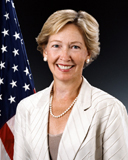News  Statements, Speeches & Interviews
Statements, Speeches & Interviews
| Statement: June 19, 2008 | |
Commissioner Kelly's statement on cost of electric generation staff presentation
"Thank you to the staff for their presentation. As I read the presentation, it left me with the question,
where do we go from here? As a federal agency in charge of energy policy and the electric industry, in
particular, what lessons does this tell us? At this point in time, I see four avenues for us to travel along.
First, I think it underscores the importance of a continuing commitment to competition in wholesale
markets. The Commission has and will continue to support competition and is working today with our
Competition NOPR to improve the competitiveness of the markets.
Second, in the area of transmission, it underscores the importance of FERC's policies to improve
transmission access to the resources that the consuming public wants to have built. Right now, not
surprisingly, those are renewable resources. It is not surprising because the cost of those resources is
much more predictable and stable without having to factor in the rising, volatile costs of fossil fuels. In
crafting our policies towards getting the necessary transmission built, I think it is incumbent upon us to
ensure that our policies to incent transmission do not contribute to rising costs. We should be very careful
about using our incentive authority in a way that does not have the unintended consequence of
unnecessarily raising the costs for transmission. As the presentation shows, the head room that we have,
and that the American consuming public has, for cost increases coming from a regulator is decreasing,
because the costs that we do not have control over are rising quickly and greatly.
Those are two of the avenues I think we need to be traveling on, on the supply side, but I think there are
also two avenues on the demand side that are important for us. First of all, as we think about the cost
increases reported in this presentation and the nation's concern about climate change, I think we have to
also remember that there are other issues, concerns, and problems in our economy that compound this
cost problem. We have a weak dollar. We have an economic slowdown - some would call it a recession.
We have the prospect of inflation. We have a financial sector that has been battered by financial crises,
and credit is tight. This makes the whole notion of building more electricity infrastructure a difficult one.
It is not easy to build expensive, long-lived assets today in a constrained and uncertain world. Frankly,
we see around the country that this is not appealing to the electric industry consumer. We have seen
responses in states, the cancelling of plants, and the issuance of renewable portfolio standards including
the expansion of those standards to set goals for efficiency. In other words, there is decreasing
enthusiasm for building and an increased enthusiasm for demand-side resources.
This reminds of the importance of a continuing commitment to developing markets for demand response,
where we have jurisdiction to do that, for efficiency, and for incorporating alternatives to generation into
our planning processes and the planning processes that the utilities under our jurisdiction need to engage
in - transmission. I think we are doing a good job towards that end. We are working on approving
compliance filings filed by transmission providers to implement robust transmission planning processes
that achieve our goals. We have NOPRs in place to look at increasing our markets for demand response and efficiency. I think that is a good thing.
The fourth avenue is something that we have just started to look at, and that is the importance of
developing a smart grid. Optimizing the design and operation of our transmission and distributions can
yield great efficiencies and a decrease in use of electricity. Having a smart grid in place will allow for
applications that will facilitate and increase demand-side resources, as well as energy efficiency. To that
end, FERC is coordinating with the Department of Commerce and the Department of Energy to develop
interoperability standards for a robust and efficient smart-grid system. FERC has initiated a collaborative
with NARUC, because state regulators are also key to the deployment of a smart grid. That collaborative
is working to help all regulators understand the cost and benefits of smart-grid applications and the
barriers that exist to actually deploying this technology.
Finally, as we search for ways to facilitate the transition to a smart grid, we must remember that 30 years
ago, when we were faced with somewhat similar situations, there was a failure of regulation to achieve
what the public wanted - lower costs. I think this presentation is very timely and impresses upon us,
being in a similar situation, that we do not want to lose sight of the fact that we have a responsibility,
together with our state regulators, to help deploy the solutions that will keep these costs in check and
perhaps lower them. It is not going to be easy, but I am sure that we can do it with a commitment to
that end."

